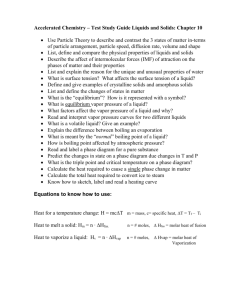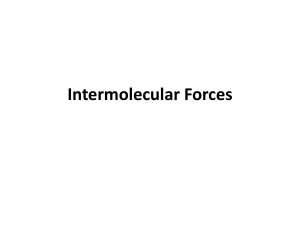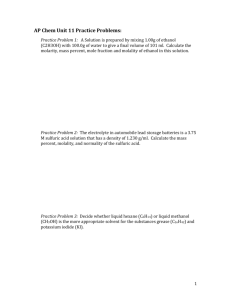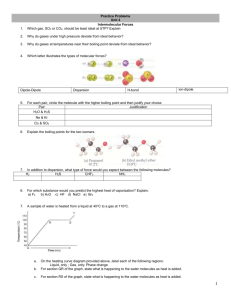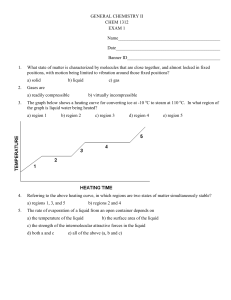Chem 1721 Review Exam 1
advertisement
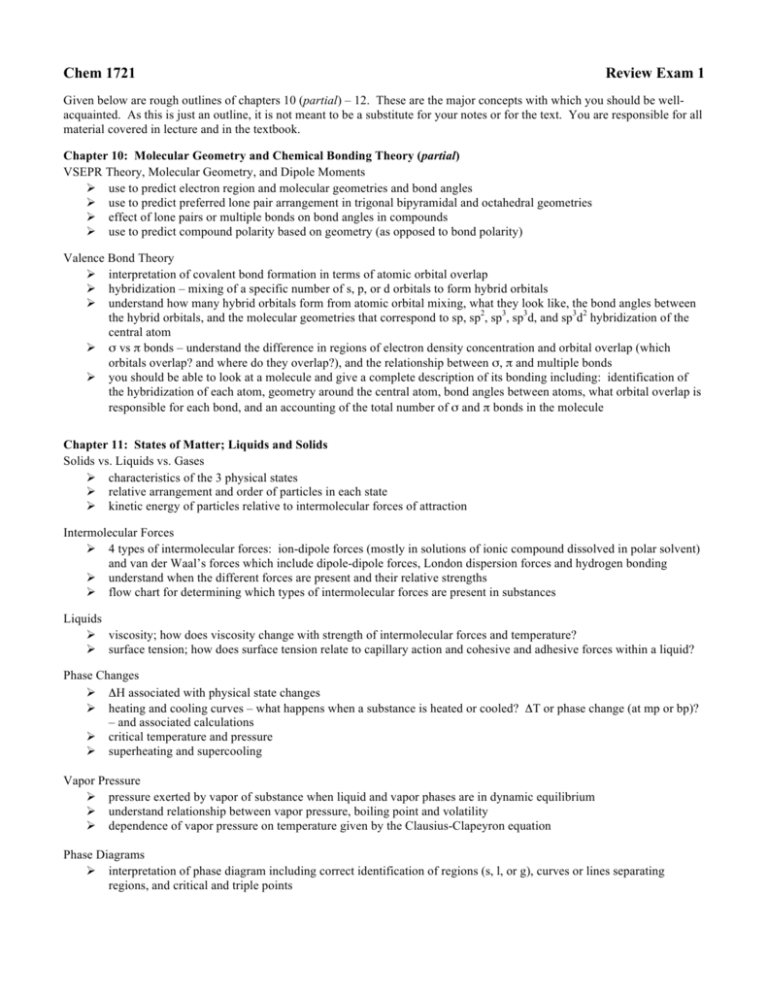
Chem 1721 Review Exam 1 Given below are rough outlines of chapters 10 (partial) – 12. These are the major concepts with which you should be wellacquainted. As this is just an outline, it is not meant to be a substitute for your notes or for the text. You are responsible for all material covered in lecture and in the textbook. Chapter 10: Molecular Geometry and Chemical Bonding Theory (partial) VSEPR Theory, Molecular Geometry, and Dipole Moments use to predict electron region and molecular geometries and bond angles use to predict preferred lone pair arrangement in trigonal bipyramidal and octahedral geometries effect of lone pairs or multiple bonds on bond angles in compounds use to predict compound polarity based on geometry (as opposed to bond polarity) Valence Bond Theory interpretation of covalent bond formation in terms of atomic orbital overlap hybridization – mixing of a specific number of s, p, or d orbitals to form hybrid orbitals understand how many hybrid orbitals form from atomic orbital mixing, what they look like, the bond angles between the hybrid orbitals, and the molecular geometries that correspond to sp, sp2, sp3, sp3d, and sp3d2 hybridization of the central atom σ vs π bonds – understand the difference in regions of electron density concentration and orbital overlap (which orbitals overlap? and where do they overlap?), and the relationship between σ, π and multiple bonds you should be able to look at a molecule and give a complete description of its bonding including: identification of the hybridization of each atom, geometry around the central atom, bond angles between atoms, what orbital overlap is responsible for each bond, and an accounting of the total number of σ and π bonds in the molecule Chapter 11: States of Matter; Liquids and Solids Solids vs. Liquids vs. Gases characteristics of the 3 physical states relative arrangement and order of particles in each state kinetic energy of particles relative to intermolecular forces of attraction Intermolecular Forces 4 types of intermolecular forces: ion-dipole forces (mostly in solutions of ionic compound dissolved in polar solvent) and van der Waal’s forces which include dipole-dipole forces, London dispersion forces and hydrogen bonding understand when the different forces are present and their relative strengths flow chart for determining which types of intermolecular forces are present in substances Liquids viscosity; how does viscosity change with strength of intermolecular forces and temperature? surface tension; how does surface tension relate to capillary action and cohesive and adhesive forces within a liquid? Phase Changes ΔH associated with physical state changes heating and cooling curves – what happens when a substance is heated or cooled? ΔT or phase change (at mp or bp)? – and associated calculations critical temperature and pressure superheating and supercooling Vapor Pressure pressure exerted by vapor of substance when liquid and vapor phases are in dynamic equilibrium understand relationship between vapor pressure, boiling point and volatility dependence of vapor pressure on temperature given by the Clausius-Clapeyron equation Phase Diagrams interpretation of phase diagram including correct identification of regions (s, l, or g), curves or lines separating regions, and critical and triple points Solids crystalline vs. amorphous solids crystal structures defined by a crystal lattice and corresponding unit cell (see tables below) calculations based on unit cell of substance to determine percent occupied volume and density types of solids and their characteristic bonding and properties: ionic, molecular, covalent-network, and metallic crystal lattice simple cubic body centered cubic (bcc) cubic close-packed (ccp) ABC ABC layer pattern hexagonal close-packed (hcp) AB AB AB layer pattern unit cell primative cubic body centered cubic face centered cubic (fcc) hexagonal prismatic sphere location in unit cell corner face edge within cell # of spheres per unit cell 1 2 4 % space occupied 52% 68% 74% 6 74% shared between how many cells? 8 2 4 0 Chapter 12: Solutions Process of Solution Formation thermodynamic considerations of solution formation: process may be endothermic or exothermic but always proceeds with an increase in entropy (disorder) Factors that Affect Solubility nature of solute and solvent interactions like dissolves like nonpolar solutes tend to be more soluble in nonpolar solvent polar solutes tends to be more soluble in polar solvents temperature in general, the solubility of most solids will increase with increasing temperature the solubility of a gas will decrease with increasing temperature pressure the solubility of liquids and solids is not generally affected by changes in pressure the solubility of a gas will increase as pressure increases; relationship given by Henry's Law Expressions of Solution Composition you should know the definition of the following terms, and be able to do calculations to determine the various relationships: mass percent composition parts per million (ppm) parts per billion (ppb) mole fraction (χ) molality (or molal concentration, m) molarity (or molar concentration, M) Properties of Solutions vapor pressure the addition of a nonvolatile solute to a solvent will result in a solution with a lower vapor pressure than the vapor pressure of the pure solvent Raoult's Law: Psoln = χsolvPºsolv if a solution is composed of 2 volatile components, each component will follow Raoult's Law freezing point depression the freezing point of a solution is lower than the freezing point of the pure solvent ΔTf = Kf•m boiling point elevation the boiling point of a solution is higher than the boiling point of the pure solvent ΔTb = Kb•m osmotic pressure osmosis is the net movement of solvent molecules through a semi-permeable membrane from a region of lower concentration to a region of higher concentration the osmotic pressure is the pressure required to to osmosis Π = MRT properties of solutions can be used to determine the molar masses of solutes you should understand the different behavior of electrolyte vs. nonelectrolyte solutes - particularily in terms of conentration and the effet on solution properties Some review problems: The purpose of these review problems is simply to provide you with extra practice. In no way should you interpret these problems to be a representation of the exam. In other words . . . DO NOT EXPECT THE EXAM TO LOOK LIKE THIS!! 1. Explain the bonding in the each of the following compounds. Identify the hybridization of the central atom, the bond angles, and the orbitals that overlap for bond formation. a. AsH3 b. BeF3– c. BrF3 d. AsCl5 e. ClF4+ f. PF5 g. C2H4 2. Consider the following reaction: BF3 + NH3 → F3B-NH3. Describe any changes in hybridization (if any) of the B and N atoms as a result of this reaction. 3. What hybrid orbitals are used by nitrogen atoms in the following species? a. NH3 b. H2N-NH2 c. NO3– 4. The allene molecule H2C=C=CH2 is linear with the 3 carbon atoms lie in a straight line. What is the hybridization of each carbon atom? Draw diagrams to show the formation of sigma and pi bonds in allene. 5. How many sigma and pi bonds are in each of the following molecules? 6. Identify the most important type of intermolecular force present in each of the following: a. BaSO4 g. H2O b. H2S h. C6H6 c. Xe i. CH3Cl d. C2H6 j. PF3 e. CsI k. CS2 f. P4 7. Predict which substance in each of the following pairs would have the greatest intermolecular forces: a. PF3 or PF5 b. SF2 or SF6 c. SO3 or SO2 8. Rationalize the difference in normal boiling points for each of the following pairs of substances: a. dimethyl ether, CH3OCH3 bp = –25° C and ethanol, CH3CH2OH, bp = 79°C b. HF, bp = 20°C and HCl, bp = –85°C c. HCl, bp = –85°C and LiCl, bp = 1360°C d. n-pentane, CH3CH2CH2CH2CH3 bp = 36.2°C and n-propane, CH3CH2CH3 bp = –42°C e. n-propane, CH3CH2CH3 bp = –42°C and dimethyl ether, CH3OCH3 bp = –25°C 9. Cobalt has a cubic close packed structure and an atomic radius of 125 pm. Calculate the density (in g/cm 3) of Co. 10. Calculate the total energy required to convert 0.500 kg of ice at –20°C to steam at 250°C. For water: molar mass = 18.02 g/mol, ΔHfus = 6.02 kJ/mol, ΔHvap = 40.7 kJ/mol, mp = 0°C, bp = 100°C, s for H2O (s) = 2.1 J/g°C, s for H2O (l) = 4.18 J/g°C, s for H2O (g) = 2.0 J/g°C. 11. Classify each of the following solids as ionic, molecular, metallic, or covalent-network. a. CO2 f. I2 b. SiO2 g. KBr c. Si h. H2O d. CH4 i. NaOH e. Ru j. PH3 12. Explain the term polarizeability. What kind of molecules tend to have high polarizeabilities? What is the relationship between polarizeability and intermolecular forces? 13. The compounds Br2 and ICl have the same number of e–‘s, but Br2 melts at –7.2°C and ICl melts at 27.2°C. Explain. 14. If you lived in Alaska, which of the following natural gases would you keep in an outdoor storage tank in winter? methane (CH4), propane (C3H8), or butane (C4H10)? Explain why. 15. Which of the following species are capable of intermolecular hydrogen bonding? C2H6, HI, KF, BeH2, or CH3COOH 16. Arrange the following in order of increasing boiling point: RbF, CO2, CH3OH, CH3Br 17. a. b. c. d. 18. What is viscosity? What is the relationship between viscosity and intermolecular forces? What is the relationship between viscosity and temperature? 19. Predict which of the following liquids has greater surface tension: ethanol (CH3CH2OH) or dimethyl ether (CH3OCH3). 20. Crystalline silicon has a cubic structure. The unit cell edge length is 543 pm. The density of the solid is 2.33 g/cm 3. Calculate the number of Si atoms in one unit cell. 21. a. b. c. Which of the following will have the higher boiling point? O2 or Cl2 Which of the following will have the lower melting point? HF or HI Which of the following will have the highest vapor pressure? CH4 or Cl2 Which of the following will have the lower boiling point? Ne or Xe A solid is hard, brittle, and electrically nonconducting. Its melt (liquid form of the substance) and aqueous solution containing the substance conduct electricity. Classify the solid. A solid is soft and has a low melting point (below 100°C). The solid, its melt, and an aqueous solution containing the substance are all nonconductors of electricity. Classify the solid. A solid is very hard and has a high melting point. Neither the solid or its melt conduct electricity. Classify the solid. 22. Use any one of the phase changes to explain what is meant by the term dynamic equilibrium. 23. a. b. What can you learn about the strength of intermolecular forces of attraction in a substance by it molar enthalpy of vaporization? True or False: The greater the molar heat of vaporization of a liquid the greater its vapor pressure. 24. The molar heats of fusion and sublimation of molecular iodine are 15.27 kJ/mol and 62.30 kJ/mol respectively. Estimate the molar heat of vaporization of liquid iodine. 25. The vapor pressure or benzene is 40.1 mmHg at 7.6°C. What is the vapor pressure of benzene at 60.6°C? For benzene, C6H6, ΔHvap = 31.0 kJ/mol. 26. Estimate ΔHvap of a liquid whose vapor pressure doubles when the temperature is raised from 85°C to 95°C. 27. The normal boiling point and normal freezing point of sulfur dioxide are –10°C and –72.7°C respectively. The triple point is –75.5°C and 1.65 x 10–3 atm, and its critical point is 157°C and 78 atm. Use this information to sketch the phase diagram of SO2. 28. Which of the following properties indicates very strong intermolecular forces? a. low surface tension b. low critical temperature c. low boiling point d. low vapor pressure 29. What is the vapor pressure of mercury at its normal boiling point (357°C)? 30. Which has a greater density - crystalline SiO2 or amorphous SiO2? Explain. 31. Br2 is much more soluble in CCl4 than in water. Explain why. 32. Why do ionic compounds wtih higher lattice energies tend to be less soluble in water than substances with lower lattice energies? 33. Ethanol (CH3CH2OH) is miscible with water at 20ºC, but pentanol (CH3CH2CH2CH2CH2OH) is soluble in water only to the extent of 2.7 g per 100 mL. Explain. 34. Propranolol (C16H21NO2), a beta-blocker that is used for the treatment of high blood pressure, is effective at a blood plasma concentration of 50 ng/L. Express this concentration in the following units: a. parts per billion (assume a plasma density of 1.025 g/mL) b. molarity 35. Residues of the herbicide atrazine (C8H14ClN5) in water can be detected at concentrations as low as 0.050 µg/L. Express this concentration in the following units: a. parts per million (assume a solution density of 1.000 g/mL) b. molarity 36. a. b. c. 37. Determine the mass percent of solute in each of the following solutions: a. 0.655 mol citric acid (C6H8O7) dissolved in 1.00 kg water. b. 135 mg KBr dissolved in 5.00 mL of water (d = 1.00 g/mL). c. 5.50 g aspirin (C9H8O4) dissolved in 145 g dichloromethane (CH2Cl2). 38. Determine the molal concentration of each solution described in question 37 above. 39 a. b. 40. The density of a 16.0 mass % solution of sulfuric acid in water is 1.1094 g/mL. Determine the molar concentration of this solution. 41. Ethylene glycol(C2H6O2) is the principal constituent of automobile anti-freeze. If the density of a 40.0 mass % solution of ethylene glycol in water is 1.0514 g/mL, determine the molarity of the solution. 42. Vinyl chloride (H2CCHCl) is the starting material from which PVC polymer is made. The Henry's law constant for vinyl chloride is 0.091 mol/L•atm at 25ºC. Determine the concentration of dissolved vinyl chloride in water at 25ºC and partial pressure of 0.75 atm. Determine the mass (in g) of glucose (C6H12O6) required to prepare 425.0 mL of a 0.150 M solution. Determine the mass (in g) of CaBr2 required to prepare 750.0 mL of a solution with [Br–] = 0.842 M. Determine the mass (in g) of benzoic acid (C7H6O2) required in combination with 775 g chloroform (CHCl3) to prepare a 1.050 m solution. What is the molality of a solution prepared by dissolving 25.0 g H2SO4 in 1.30 L water (d = 1.00 g/mL)? What is the mole fraction of each component in a solution prepared by dissolving 2.25 g nicotine (C10H14N2) in 80.0 g CH2Cl2? 43. What is the vapor pressure in torr of the following solutions? For water at 45ºC, vapor pressure = 71.93 torr. a. a solution of 10.0 g urea (CH4N2O - a nonvolatile, nonelectrolyte solute) in 150.0 g water at 45ºC b. a solution of 10.0 g LiCl (a nonvolatile solute) in 150.0 g water at 45ºC; assume that LiCl is completely dissociated 44. Determine the vapor pressure (in torr) of a solution prepared by dissolving 16.0 g glucose (C6H12O6 - a nonvolatile, nonelectrolyte solute) in 80.0 g methanol (CH3OH) at 27ºC. The vapor pressure of pure methanol at this temperature is 140 torr. 45. Acetone (C3H6O) and ethyl acetate (C4H8O2) are volatile organic liquids frequently used as solvents. At 30ºC the vapor pressure of acetone is 285 torr, and the vapor pressure of ethyl acetate is 118 torr. Determine the vapor pressure of a solution (in torr) composed of 25.0 g acetone and 25.0 g ethyl acetate. 46. A solution is prepared by dissolving 5.00 g aspirin (C9H8O4) in 215 g chloroform (CHCl3). The boiling point of the solution is elevated by 0.47ºC over the bp of pure chloroform. Determine the value of Kb for CHCl3. 47. A solution of an unknown molecular substance in water at 300 K has an osmotic pressure of 4.85 atm. Determine the molar concentration of the solution. 48. Cellobiose is a sugar obtained by the degradation of cellulose. If 200.0 mL of an aqueous solution containing 1.500 g of cellobiose at 25ºC has an osmotic pressure of 407.2 torr, what is the molar mass of cellobiose? 49. Elemental analysis of beta-carotene, a dietary soruce of vitamin A, shows that it is composed of 10.51% H and 89.49% C by mass. Dissolving 0.0250 g of β-carotene in 1.50 g of camphor gives a freezing point depression of 1.17ºC. Determine the molar mass and molecular formula of β-carotene. For camphor, Kf = 37.7ºC/m. 50. Determine the mass (in g) of ethylene glycol (C2H6O2) that must be dissolved in 3.55 kg of water to lower the freezing point of water in an automobile radiator to –22.0 ºC. For water, Kf = 1.86ºC/m. Chem 1721: Review Exam 1 Answers sp3; σ bonds As sp3/H 1s; <109.5° sp2; σ bonds Be sp2/F sp3; 120° sp3d; σ bonds Br sp3d/F sp3; 90° and 120° sp3d; σ bonds; As sp3d/Cl sp3; 90° and 120° sp3d; σ bonds; Cl sp3d/F sp3; 90° and 120° sp3d; σ bonds; P sp3d/F sp3; 90° and 120° sp2; σ bonds C sp2/C sp2 and C sp2/H 1s, and 1 π bond C p/C p; 120° 1. a. b. c. d. e. f. g. 2. B sp2sp3; N sp3 throughout 3. a. b. c. sp3 sp3 sp2 4. 5. 10 σ bonds, 3 π bonds; 9 σ bonds, 9 π bonds; 13 σ bonds, 3 π bonds 6. a. b. c. d. e. ionic dipole-dipole London dispersion forces London dispersion forces ionic 7. a. b. c. PF3 because it is polar SF2 because it is polar SO2 because it is polar 8. a. b. c. d. e. CH3CH2OH can hydrogen bond; CH3OCH3 has only dipole-dipole forces HF can hydrogen bond; HCl has only dipole-dipole forces LiCl is ionic both are non-polar; n-pentane is larger and will have stronger London dispersion forces CH3OCH3 has dipole-dipole forces; n-propane has only London dispersion forces 9. d = 8.85 g/cm3 10. qtot = 1700 kJ (2 sig figs) 11. a. b. c. d. e. molecular covalent-network metallic or covalent-network molecular metallic f. g. h. i. j. k. f. g. h. i. j. London dispersion forces hydrogen bonding London dispersion forces dipole-dipole forces dipole-dipole forces London dispersion forces molecular ionic molecular ionic molecular 12. polarizeability – ability of an atom’s electron cloud to be distorted; generally larger (higher molar mass) species have greater polarizeability; the more polarizeable the substance the stronger the London dispersion forces 13. Br2 is non-polar, London dispersion forces only; ICl is polar, dipole-dipole forces + LDF 14. CH4 because it is smaller and will have the weakest London dispersion forces and therefore the lowest freezing point (will be liquid to a lower T) 15. CH3COOH 16. CO2 < CH3Br < CH3OH < RbF 17. a. b. c. d. 18. viscosity – resistance to flow; viscosity increases as strength of intermolecular forces increases; viscosity decreases as temperature increases 19. CH3CH2OH because it can hydrogen bond and therefore has stronger intermolecular forces 20. 8 Si atoms per unit cell 21. a. b. c. 22. dynamic equilibrium – process occurs in both forward and reverse direction at equal rate; the net population (number of particles) in each phase remains constant once equilibrium is reached 23. a. b. Cl2; both non-polar but Cl2 has stronger LDF HI; both polar but HF can hydrogen bond CH4; both non-polar but CH4 has weaker LDF and lower bp Ne; both non-polar but Ne has weaker LDF ionic molecular covalent-network higher ΔHvap means that more energy is required to cause l g change, i.e. stronger intermolecular forces of attraction False – higher ΔHvap suggests fewer particles in gas phase (because the energy cost to get there is high), and therefore lower vapor pressure 24. 47.03 kJ/mol 25. 331 mmHg (331 Torr) 26. 75.9 kJ/mol 27. 28. d – lower vapor pressure correlates to low volatility and higher bp, i.e. stronger intermolecular forces 29. 760 Torr or 1 atm 30. crystalline SiO2 – atoms in more ordered structure therefore the structure is more condensed and the solid has higher density 31. Br2 is nonpolar and so it is more soluble in nonpolar CCl4 than in polar H2O. 32. Lattice energy is a measure of the strength of the force holding ions together as an aggregate unit in the solid state. The higher the lattice energy, the harder it will be to separate or dissociate the ions, therefore water solubility will be lower. 33. Ethanol is more polar and will be miscible with water. Pentanol has a much bigger nonpolar hydrocarbon component and is therefore less polar and has lower solubility in water. 34. a. b. 0.049 ppb 1.9 x 10–10 M 35. a. b. 5.0 x 10–5 ppm 2.3 x 10–10 M 36. a. b. c. 11.5 g glucose 63.1 g CaBr2 99.4 g benzoic acid 37. a. b. c. 11.9% citric acid by mass 2.63% KBr by mass 3.65% aspirin by mass 38. a. b. c. 0.655 m 0.226 m 0.210 m 39. a. b. 0.196 m χC10H14N2 = 0.0145 χCH2Cl2 = 0.986 40. 1.81 M 41. 6.77 M 42. 0.068 mol/L 43. a. b. 44. 135 torr 45. 219 torr 46. Kb = 3.6 ºC/m 47. 0.197 M 48. 342.3 g/mol 49. 538 g/mol; C40H56 50. 2.60 x 103 g C2H6O2 70.5 torr 68.0 torr

